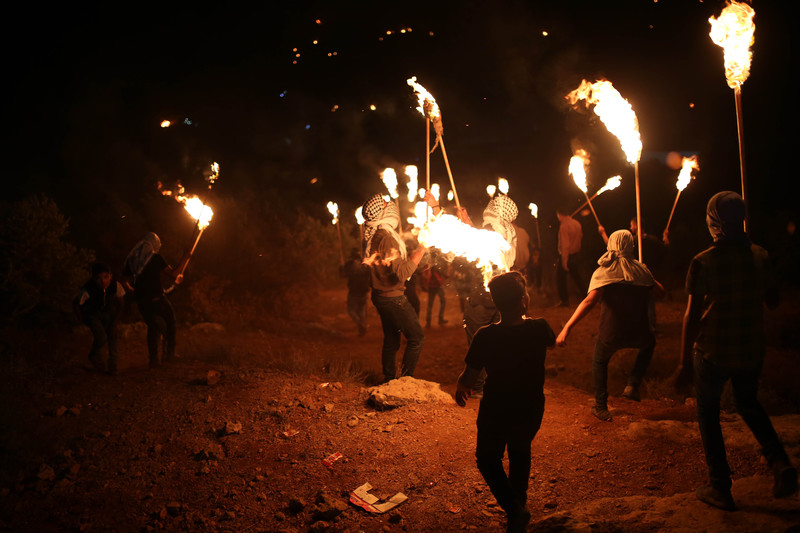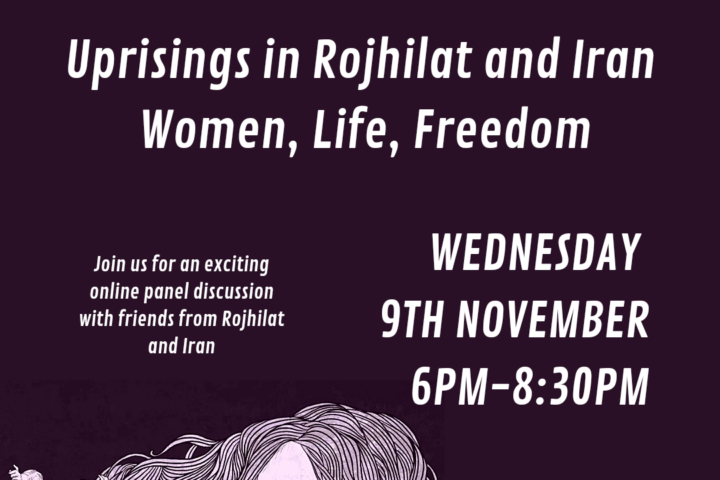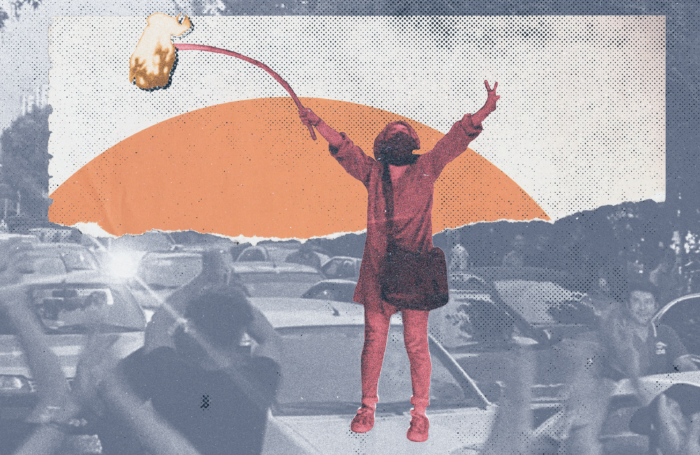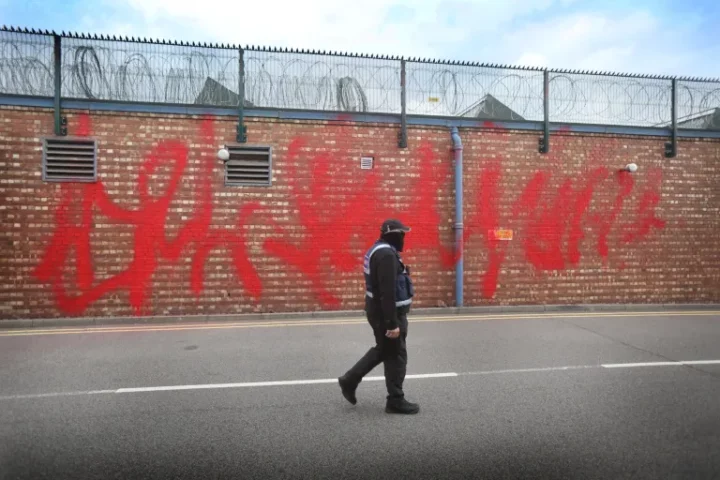Via Electronic Intifada
Hundreds of masked men marched through the darkness of night, the flames at the end of their fuel-dowsed sticks illuminating the procession gathering at the base of Jabal Sbeih (Mount Sbeih) near the Palestinian village of Beita.
Like clockwork, an assembly line formed from a truck ferrying a pile of rubber tires for burning. Towering plumes of smoke started to billow.
Soon, the protesters’ chatter became consumed by a symphony of horns and shouts.
“From Arma mountain to Sbeih mountain we won’t move,” they proclaimed, the sound of a buq (trumpet) roaring in between chants.
This was the scene every night since 3 May when Israeli settlers – for the fourth time in nearly a decade – established the Evyatar outpost on Jabal Sbeih and hundreds of Palestinians from the surrounding villages of Beita, Yatma, and Qabalan, all located southeast of the city of Nablus, turned out daily to show their defiant and loud objection.
And for the fourth time in nearly a decade, Israeli settlers here have evacuated, the 50 families leaving Jabal Sbeih on 2 July, after a deal was reached with Israeli defense minister Benny Gantz at the end of June
The prefabricated homes and an army post will remain on the land, however, while the land ownership on Jabal Sbeih is reviewed. Chances are that the settlers will return and residents are taking nothing for granted.
Locals have widely rejected the agreement, seeing it as a delaying tactic in order to usher in more permanent infrastructure.
Protesters say they will continue to come out every day until the construction is razed and the army outpost removed.
Creative resistance
Leading up to the deal, locals had deployed a number of creative methods of defiance to the settlers’ expansion efforts.
Every night, as dusk fell across the valley, protests which had begun during the day took on a different form. Locals described the after-dark actions as “night confusions.”
Wielding laser pointers and fire sticks, the men assembled in units, each one tasked with burning tires, setting off fireworks, or launching stones from slingshots.
According to protesters, inspired by the 2018 Great March of Return rallies in Gaza, the aim was to keep a constant disturbance directed at the settlers.
“We are 38 people in my family and we have all been going to the protests everyday, and we will continue to do so peacefully until they [settlers] leave,” Muhammad Mustafa, 68, one of the farmers who owns the land of the outpost, told the Electronic Intifada.
The outpost was established after three settlers were shot at Zaatara military checkpoint in the northern West Bank on 2 May, one of whom later died from his injuries.
According to Mohammed Raee, a field researcher for the Palestinian rights organization Al-Haq, since 3 May settlers managed to construct 50 temporary homes and a paved road on the land under the protection of the Israeli military.
Photographs published in Israeli media earlier this month showed soldiers assisting settlers in the construction of the outpost.
The military released a statement on 4 June stating that the soldiers presence was required in order to “protect” settlers from Palestinian residents. Israeli soldiers have responded to the local resistance by firing a constant barrage of live ammunition, tear gas and stun grenades on demonstrators, resulting in the deaths of five Palestinians and hundreds of injuries.
Photographs honoring the four Beita residents who were slain line the streets of the town. They include Ahmad Bani-Shamsa, 15, who was shot in the head by an Israeli soldier on 16 June, and Mohammed Hammayel, 16, who was shot in the chest on 11 June.
Another man, Tareq Snobar was killed during a protest against the Evyatar outpost in the village of Yatma on 14 May, only 48 hours after the birth of his son, Omar.
Protesters have also clashed with soldiers at the entrance to the town of Beita. Fathi Hammayel, a local construction worker, said he witnessed soldiers throw stun grenades into the main fruit and vegetable market, setting fire to the stands there.
It has not deterred him or his three sons, who have been going to the protests every day.

“I go back and forth from work to the protests in shifts, only taking breaks for food and rest,” Hammayel told The Electronic Intifada.
Women in the village have also banded together to help sustain the protests by cooking for the demonstrators.
According to Musa Hammayel, the deputy mayor of Beita, the Israeli army closed the main entrance for a week and repeatedly blocked multiple entrances to the village.
Daily protests have also targeted the adjacent Jabal al-Arma where settlers have also repeatedly attempted to establish an outpost.
A history of resistance
According to Al-Haq’s Mohammed Raee, this is the settlers’ fourth attempt to take over the land on Jabal Sbeih, dating back to an original attempt in 2013 when a settler named Evyatar Borovsky was killed at Zaatara checkpoint. After an outcry and protests from Palestinian residents, the outpost was razed by the army.
Settlers acted again in 2018 when a rabbi was killed near the settlement of Ariel, located in the district of Salfit, managing to erect multiple temporary homes on the mountaintop and equip them with running water and electricity. Again, however, locals were able to protest until the settlement was dismantled.
Palestinians once again succeeded in standing defiant against illegal construction efforts in 2020 when settlers tried to set up caravans on the mountains of Sbeih, al-Arma and al-Najma, on land woven between Beita, Qabalan, and Yatma.
The settlers are mostly drawn from the nearby settlement of Yitzhar, notorious for particularly violent radicalized Jewish settlers known as the hilltop youth who commit frequent attacks against Palestinians in the area.
So violent are the settlers there that Al-Haq issued an appeal to the United Nations on 17 February demanding immediate intervention in the protection of the local population from violent Yitzhar settlers.
Established in 1983 on the land of Jabal Salman, Yitzar became well known among human rights groups for “price tag” attacks carried out by its residents.
“Price tag” attacks are carried out in response to any threat perceived by settlers. They have targeted Palestinians and their property or Israeli forces in a bid to deter any attempts to remove settlements in occupied territory.
In 2017, the Israeli high court enacted the Regularization Law, which would have allowed for the expropriation of “private Palestinian land in the West Bank and to ‘regularize’ or ‘legalize’ the Israeli settlements built on it” read a report by Adalah, a human rights group.
Due to the combined efforts from human rights groups and multiple Palestinian local authorities, the law was later suspended for review by the high court.
Jabal Sbeih is located in Area C, which makes up some 60 percent of the West Bank where Israel retains full control over security and land-management.
Protesters’ dogged resistance to settler expansion on the mountain represents a rare instance of sustained defiance compared to the many other Palestinian villages that have falllen victim to Israel’s illegal land grabs. All settlements in the West Bank are illegal under international law.
Fathi Hammayel’s sons, all of whom have permission to work inside Israel, reported having their permits revoked by their Israeli employers once it was discovered they were from Beita.
“My sons are now unemployed, what can we do? They [Israel] are making us suffer in every way,” Hammayel said.
Demonstrators also allege that they have received calls from Israeli intelligence officers threatening them not to continue protesting.
“They told me they would arrest me if I continued to go to the protests,” Basil Mustafa, a Beita local, told The Electronic Intifada.
Two of Mustafa’s brothers were arrested in their homes during a raid by Israeli soldiers in the village in the early morning of 19 June, one of whom had suffered an injury to his chest just two days before. Mustafa said he has not heard from his brothers since their arrest.
Palestinian land owners from the villages of Beita, Qabalan, and Yatma received further authentication of their ownership rights to Jabal Sbeih from 1935 in an Israeli court on 15 June.
Settlers defied Israeli military orders issued on 9 June demanding a suspension in construction efforts and declaring the whole area a closed military zone. The settlers continued to build, while Palestinian landowners were blocked from accessing what Mosa Hammayel, the deputy mayor, said were 845,000 square meters of land for farming.
The land on Jabal Sbeih is of important strategic interest for settler expansion as it would effectively make Zaatara checkpoint a gateway connecting the settlement outpost Beit Dajan to the Ariel settlement through a road network that will also sever the north of the West Bank from the southern and eastern parts.
Shahd Qaddoura, a legal researcher with Al-Haq investigating the issue, says this would have severe consequences for Palestinians across the West Bank.
“The mere idea of constructing a settlement on Jabal Sbeih would mean these three Palestinian villages would be extremely fragmented, negatively impacting Palestinians’ freedom of movement in the area,” Qaddoura said.
Zuheir Bani Shamsa owns a supermarket in Beita. He broke his arm when he fell while trying to run away from Israeli gunfire during a protest.
Sporting a makeshift cast, Bani Shamsa has delayed getting medical treatment in order to continue attending the demonstrations
“I will never stop defending the land,” Bani Shamsa said.
One-sided agreement
According to Mohammed Raee of Al-Haq, the land has been cultivated by Palestinian olive farmers since 1935.
Basil Mustafa has not been able to reach his land since 3 May, depriving him of his livelihood on farmland generations before him have lived off.
“How would you feel if you were standing in front of where your father had planted and was exhausted by this land, just to be stolen by Israeli settlers at the snap of a finger?” Mustafa asked.
Under the agreement struck 30 June between Benny Gantz and the settlers, the Israeli government will now try to determine land ownership of the area.
If Israel determines that the mountaintop acreage was not in use by local farmers it could be claimed – under a law dating back to the Ottoman era – as “state-owned” land. Settlement activities, including plans for a yeshiva, a religious school, might commence again.
“This is a one-sided agreement. Whether it is a religious school or military post, we won’t accept anything but a full evacuation,” Musa Hammayel, Beisa’s deputy mayor, told The Electronic Intifada.
According to Shahd Qaddoura from Al-Haq, settlers seized the opportunity to take over Jabal Sbeih while international focus was concentrated on forced expulsion efforts in East Jerusalem, violent incursions on the al-Aqsa mosque compound, and the assault on Gaza in May.
“This is a delaying tactic, the Israeli government is just trying to buy time so our people stop protesting, they don’t have anything,” Musa Hammayel said.
The agreement was also given a green light at from a fragile new government coalition scraped together at the beginning of June. The new government is headed by Naftali Bennett, a far-right politician.
Calling themselves the “guardians of the mountain,” protesters say they will continue to come out in their hundreds to defend the land no matter how many times settlers return.
“Israel may have the military power,” Fathi Hammayel, the construction worker, said. “But we have a stronger desire and will to stay.”
Kelly Kunzl is an American freelance journalist, reporting on Palestine.




